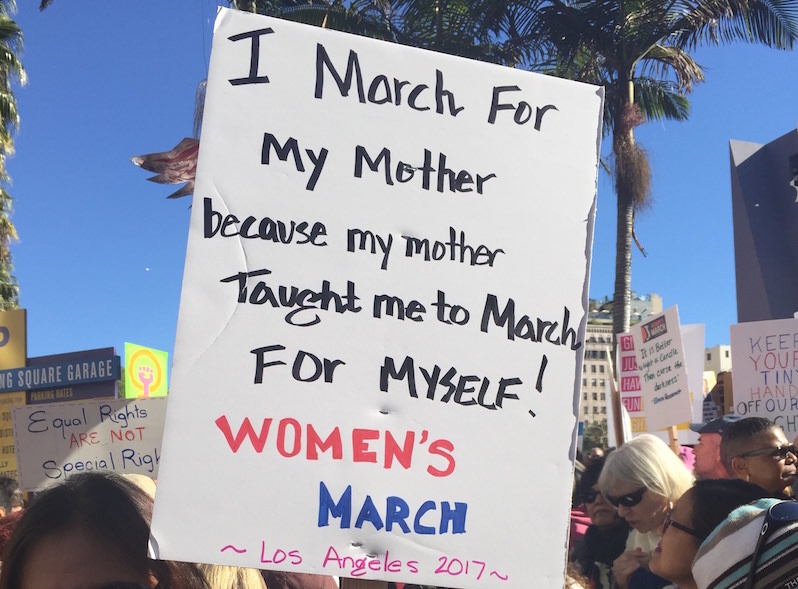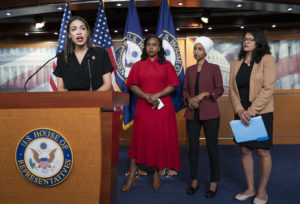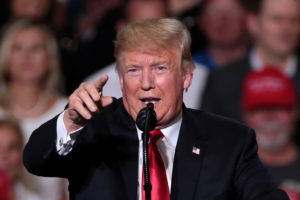Women’s Marches Show That People Will Stand Up to an Intolerant ‘America First’ Vision
The demonstrations around the world are a first step toward resisting Donald Trump. But there is much more to do.
Melissa Erickson, one of the marchers in Los Angeles on Saturday. (Bill Boyarsky / Truthdig)
After observing, via television, the unrelenting negativity of President Donald Trump’s inaugural speech, I wondered whether people who reject his values have the heart to resist.
There are plenty who do. That’s what I found Saturday when I joined the women, men and young people who crowded my Metro station for the ride to downtown Los Angeles, where hundreds of thousands gathered for the Women’s March. I squeezed into the packed train car, the door closing about an inch behind me. “You made it,” a young man said. “I knew I would,” I replied.
READ: Millions Demonstrate in Over 600 Rallies in 20 Countries Around the World
Elsewhere, hundreds of thousands demonstrated in Women’s Marches in cities around the country, including Washington, D.C., New York, Boston and Chicago. The Women’s March on Washington, the center of Trumpism, was the national focal point. But strong feelings were expressed in other cities, where crowds exceeded expectations.
Commuter trains, buses, cars, taxis and Uber rides were bringing people to the L.A. march from all over Southern California. I joined crowds so thick in the streets around the Pershing Square gathering place that it was difficult to move. The same was true on the march route to City Hall, and at City Hall itself. Organizers said 750,000 showed up. Los Angeles police said the crowd appeared to be well over 100,000 and that it was the biggest event in Los Angeles since an immigration rights march attended by 500,000 a decade ago.
“Excuse me, excuse me,” I frequently said, as I worked my way past marchers. I looked around at the makeup of the crowd. Most were women. Most were white, not reflecting the Los Angeles population, which is primarily Latino, Asian-American and African-American. It reminded me of a Bernie Sanders crowd—same ethnic breakdown, same serious determination and same courteous manner.
The many signs reflected the feminist and anti-Trump feelings of the women and men. I particularly liked one that said, “I march for my mother because my mother taught me to march for myself.”
“Our hope is that our message is received,” said Melissa Erickson, the woman who held the sign. “I hope we can stay in the 21st century where science is real,” added Erickson, who is a special education teacher from Santa Barbara. Perhaps taking note of my gray hair, she said, “If not for yourself, for your children and your grandchildren and your great-grandchildren.”
“I think we are trying to show how many people do not support Trump,” said Sarah Strange, another schoolteacher. “Then we can inspire people to vote. We have a lot more to do after today. I coach girls’ soccer, and a lot of my girls are upset.”
“There can be change, especially with the Senate in two years,” said her mother, Susan Strange, who helps run a teacher-education program at California State University, San Bernardino.
“Organize, inspire,” said a marcher named Andrew Oshrin.
I don’t know whether the anti-Trump forces can do it. The march in Los Angeles, no matter how well attended, didn’t indicate how people feel in many other parts of the nation. The city and the state of California are overwhelmingly Democratic and anti-Trump.
I was also concerned about the racial composition of the crowd. Because it didn’t reflect the multiethnic nature of Southern California, it showed that the women’s march didn’t reach deeply into the population. Hopefully, that wasn’t true in the rest of the country.
READ: President Donald Trump Is Ushered In With Pomp and Protest
But the goals of the march organizers have broad appeal even though these organizers tend to deal in generalities. The marches, they say, go beyond Trump. Their platform is simple: Women’s rights are human rights. There should be accountability and justice in cases of police shootings. Freedom from sexual violence should be assured, and the Equal Rights Amendment should be ratified. In addition, there should be guarantees for reproductive rights, and rights for LGBTQ people, immigrants and refugees.
It appears none of these goals will be attained under a Trump administration with a Republican Congress that either agrees with the president or lacks the courage to oppose him.
Rather, in his inaugural address, Trump embraced intolerance in the guise of patriotism. As Samuel Johnson said, “Patriotism is the last refuge of the scoundrel.”
To Trump, “America First” means Muslim immigrants last. As he expands his vision, “America First” could mean action against immigrants of all ethnicities—and others who don’t fit into his view of America.
The Women’s Marches were a first step toward resisting him. But as some marchers told me, there is much more to do.
Independent journalism is under threat and overshadowed by heavily funded mainstream media.
You can help level the playing field. Become a member.
Your tax-deductible contribution keeps us digging beneath the headlines to give you thought-provoking, investigative reporting and analysis that unearths what's really happening- without compromise.
Give today to support our courageous, independent journalists.




You need to be a supporter to comment.
There are currently no responses to this article.
Be the first to respond.